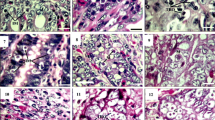Summary
The susceptibility of Meriones unguiculatus to Nippostrongylus muris depends on the age of the host. Four to six-week-old animals are particularly susceptible: infection with as few as <200 larvae resulted in the death of 6 out of 12 Meriones. Eighteen-month-old animals tolerated 800 larvae without showing any clinical manifestations. The first eggs of Nippostrongylus muris were detected in the feces 136 h after infection. Maximum egg output was seen on the 7th and 8th day, respectively, after infection. Coprological examination was negative on the 14th day after infection in all Meriones; at that time elimination of the parasites is practically complete. Twelve hours after infection the first larvae were detectable in the lungs, the maximum being reached 40 h after infection. The virulence of Nippostrongylus muris had increased after five passages in Meriones (Table 3). In contrast, the virulence in rats had subsided after re-infection (Table 4). Meriones unguiculatus were largely immune after a second and third infection. Seven days after the third infection developmental stages of the parasites could be detected in the lungs on histological examination.
Zusammenfassung
Die Empfänglichkeit von Meriones unguiculatus gegenüber Nippostrongylus muris steht in Abhängigkeit vom Alter des Wirtes. Besonders empfänglich sind 4–6 Wochen alte Tiere; bereits <200 Larven führten bei 6 von 12 Meriones zum Exitus. 18 Monate alte Tiere vertrugen 800 Larven ohne klinische Erscheinungen. 136 Std nach der Infektion wurden erstmals Eier von Nippostrongylus muris im Kot nachgewiesen. Die Maxima in der Eiausscheidung ergaben sich am 7. bzw. 8. Tag p.i. Am 14. Tag nach der Infektion waren alle Meriones koprologisch negativ; zu diesem Zeitpunkt ist die Elimination der Parasiten so gut wie abgeschlossen. In der Lunge waren 12 Std p.i. die ersten Larven nachweisbar mit einem 40 Std p.i. erreichten Maximum. Fünf Passagen von Nippostrongylus muris in Meriones hatten eine Virulenzsteigerung zur Folge. Dagegen kam es bei Ratten nach Rückinfektion zur Abschwächung der Virulenz. Nach einer Zweit- und Drittinfektion waren Meriones unguiculatus weitgehend immun. Histologisch ließen sich 7 Tage nach der Drittinfektion Entwicklungsstadien in der Lunge nachweisen.
Similar content being viewed by others
Literatur
Brakett, S., Bliznick, A.: Screening large numbers of new chemical compounds for anthelmintic activity using infections with Nippostrongylus muris in mice. J. Parasit. 35, 8–18 (1949)
Graham, G. L.: Resistance studies with the nematode, Nippostrongylus muris, in laboratory rats. Amer. J. Hyg. 20, 352–372 (1934)
Haley, A. J.: Host specificity of the rat nematode, Nippostrongylus muris. Amer. J. Hyg. 67, 331–349 (1958)
Haley, A. J.: Biology of the rat nematode, Nippostrongylus brasiliensis. I. Systematics, hosts and geographic distribution. J. Parasit. 47, 727–732 (1961)
Haley, A. J.: Biology of the rat nematode, Nippostrongylus brasiliensis (Travassos, 1914). II. Preparasitic stages and development in the laboratory rat. J. Parasit. 48, 13–23 (1962)
Kassai, T., Aitken, J. D.: Induction of immunological tolerance in rats to Nippostrongylus brasiliensis infection. Parasitology 57, 403–418 (1967)
Lämmler, G., Zahner, H., Texdorf, I.: Infektionsversuche mit Darmnematoden, Cestoden und Trematoden bei Mastomys natalensis (Smith, 1834). Z. Parasitenk. 31, 166–202 (1968)
Mulligan, W., Urquhart, G. M., Jennings, F. W., Neilson, J. T. M.: Immunological studies on Nippostrongylus brasiliensis infection in the rat. The “self-cure” phenomenon. Exp. Parasit. 16, 341–347 (1965)
Ogilvie, B. M., Jones, V. E.: Nippostrongylus brasiliensis: a review of immunity and the host: parasite relationship in the rat. Exp. Parasit. 29, 138–177 (1971)
Porter, D. A.: A comparative study of Nippostrongylus muris in rats and mice. Amer. J. Hyg. 22, 444–465 (1935)
Taliaferro, W. H., Sarles, M. P.: The cellular reactions in the skin, lungs and intestine of normal and immune rats after infection with Nippostrongylus muris. J. infect. Dis. 64, 157–192 (1939)
Solomon, M. S., Haley, A. J.: Biology of the rat nematode Nippostrongylus brasiliensis (Travassos, 1914). V. Characteristics of N. brasiliensis after serial passage in the laboratory mouse. J. Parasit. 52, 237–241 (1966)
Spedding, C. R. W.: Variation in the egg content of sheep faeces within one day. J. Helminth. 26, 71–86 (1952a)
Spedding, C. R. W.: The value of the faecal egg count in sheep. Vet. Rec. 64, 813–815 (1952b)
Twohy, D. W.: The early migration and growth of Nippostrongylus muris in the rat. Amer. J. Hyg. 63, 165–185 (1956)
Wescott, R. B., Todd, A. C.: Adaptation of Nippostrongylus brasiliensis to the mouse. J. Parasit. 52, 233–236 (1966)
Author information
Authors and Affiliations
Additional information
Herrn Prof. Dr. Karl Winnacker zum 70. Geburtstag gewidmet.
Auszugsweise vorgetragen auf der VI. Tagung der DGP, Hannover 1972.
Rights and permissions
About this article
Cite this article
Kirsch, R. Zur Biologie von Nippostrongylus muris bei Meriones unguiculatus . Z. Parasitenk. 42, 137–145 (1973). https://doi.org/10.1007/BF00329790
Received:
Issue Date:
DOI: https://doi.org/10.1007/BF00329790




